Economics Principles Assignment Solution for BEO1105 Course
VerifiedAdded on 2020/02/19
|14
|2006
|43
Homework Assignment
AI Summary
This economics assignment solution addresses key concepts in microeconomics, including the distinction between change in demand and change in quantity demanded, and the factors influencing these changes. It analyzes market equilibrium scenarios, such as oversupply due to prices above equilibrium, and the impact of substitute goods and increased competition on solar panel markets. The assignment further explores supply and demand dynamics using the example of watermelon seasonality, demonstrating how supply fluctuations affect prices. It also examines how shifts in demand and supply for yoga services, influenced by government regulations, impact market equilibrium. Finally, the solution assesses price elasticity of demand, using the example of music CDs, and discusses the implications of market entry restrictions on industry profitability within a perfectly competitive market structure. The document provides diagrams and references to support the analysis.
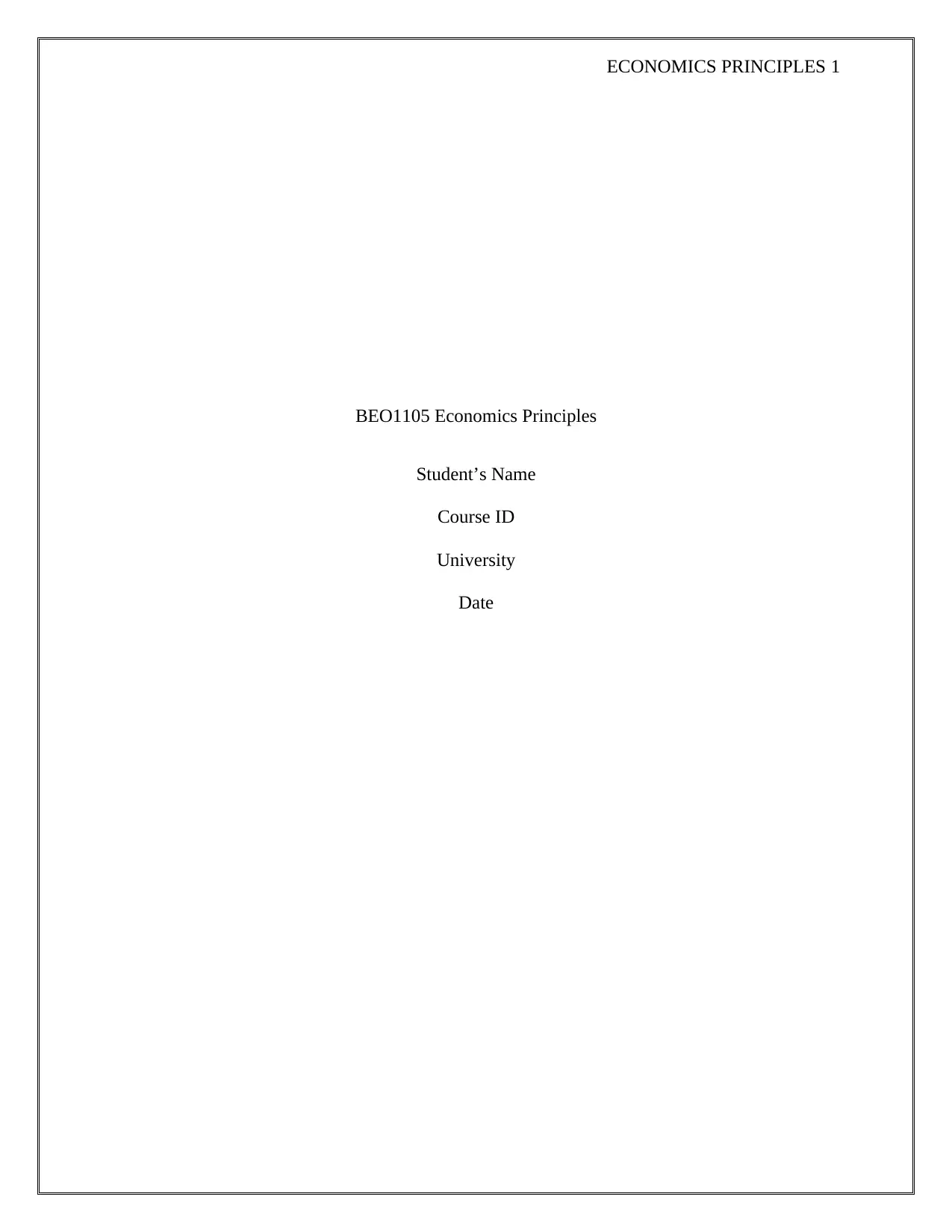
ECONOMICS PRINCIPLES 1
BEO1105 Economics Principles
Student’s Name
Course ID
University
Date
BEO1105 Economics Principles
Student’s Name
Course ID
University
Date
Paraphrase This Document
Need a fresh take? Get an instant paraphrase of this document with our AI Paraphraser
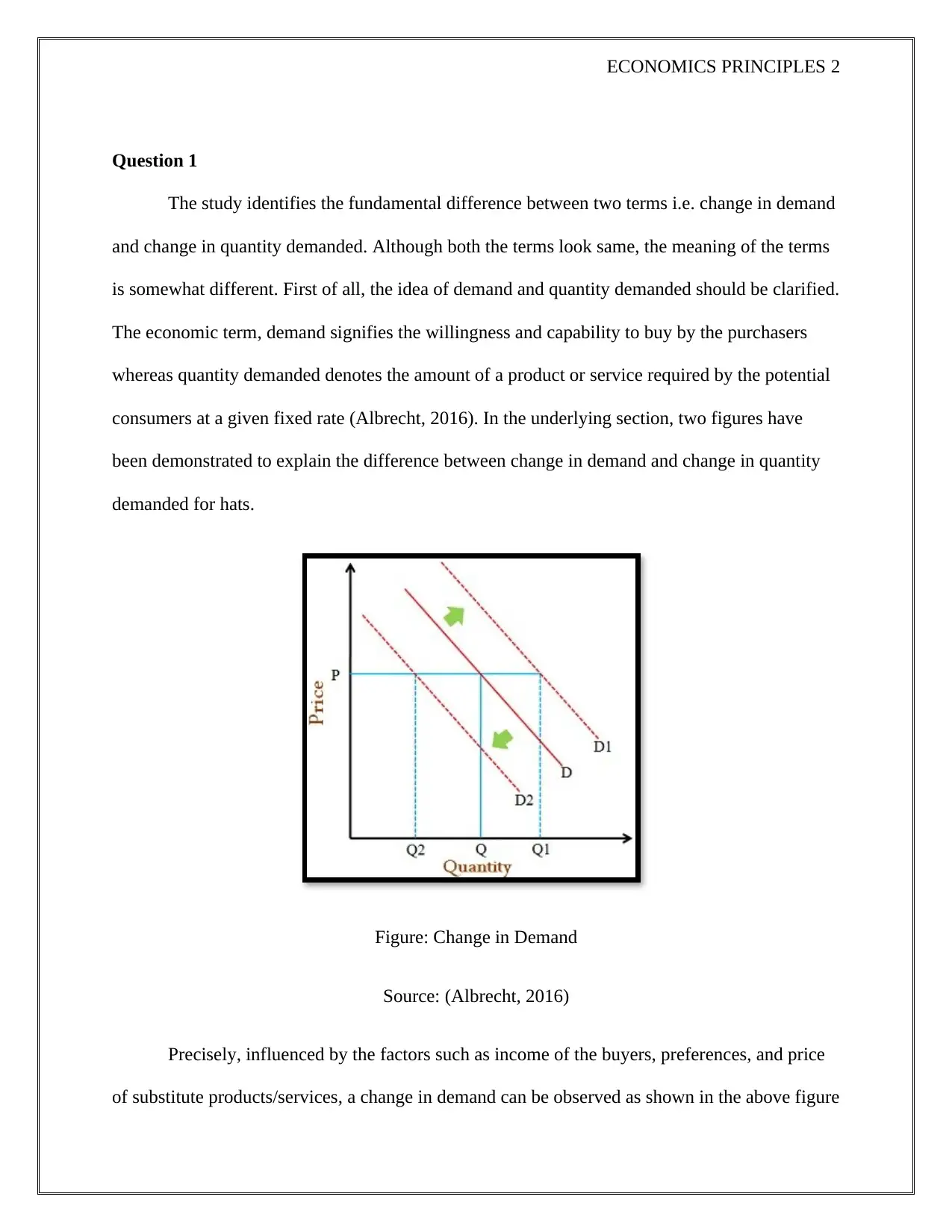
ECONOMICS PRINCIPLES 2
Question 1
The study identifies the fundamental difference between two terms i.e. change in demand
and change in quantity demanded. Although both the terms look same, the meaning of the terms
is somewhat different. First of all, the idea of demand and quantity demanded should be clarified.
The economic term, demand signifies the willingness and capability to buy by the purchasers
whereas quantity demanded denotes the amount of a product or service required by the potential
consumers at a given fixed rate (Albrecht, 2016). In the underlying section, two figures have
been demonstrated to explain the difference between change in demand and change in quantity
demanded for hats.
Figure: Change in Demand
Source: (Albrecht, 2016)
Precisely, influenced by the factors such as income of the buyers, preferences, and price
of substitute products/services, a change in demand can be observed as shown in the above figure
Question 1
The study identifies the fundamental difference between two terms i.e. change in demand
and change in quantity demanded. Although both the terms look same, the meaning of the terms
is somewhat different. First of all, the idea of demand and quantity demanded should be clarified.
The economic term, demand signifies the willingness and capability to buy by the purchasers
whereas quantity demanded denotes the amount of a product or service required by the potential
consumers at a given fixed rate (Albrecht, 2016). In the underlying section, two figures have
been demonstrated to explain the difference between change in demand and change in quantity
demanded for hats.
Figure: Change in Demand
Source: (Albrecht, 2016)
Precisely, influenced by the factors such as income of the buyers, preferences, and price
of substitute products/services, a change in demand can be observed as shown in the above figure
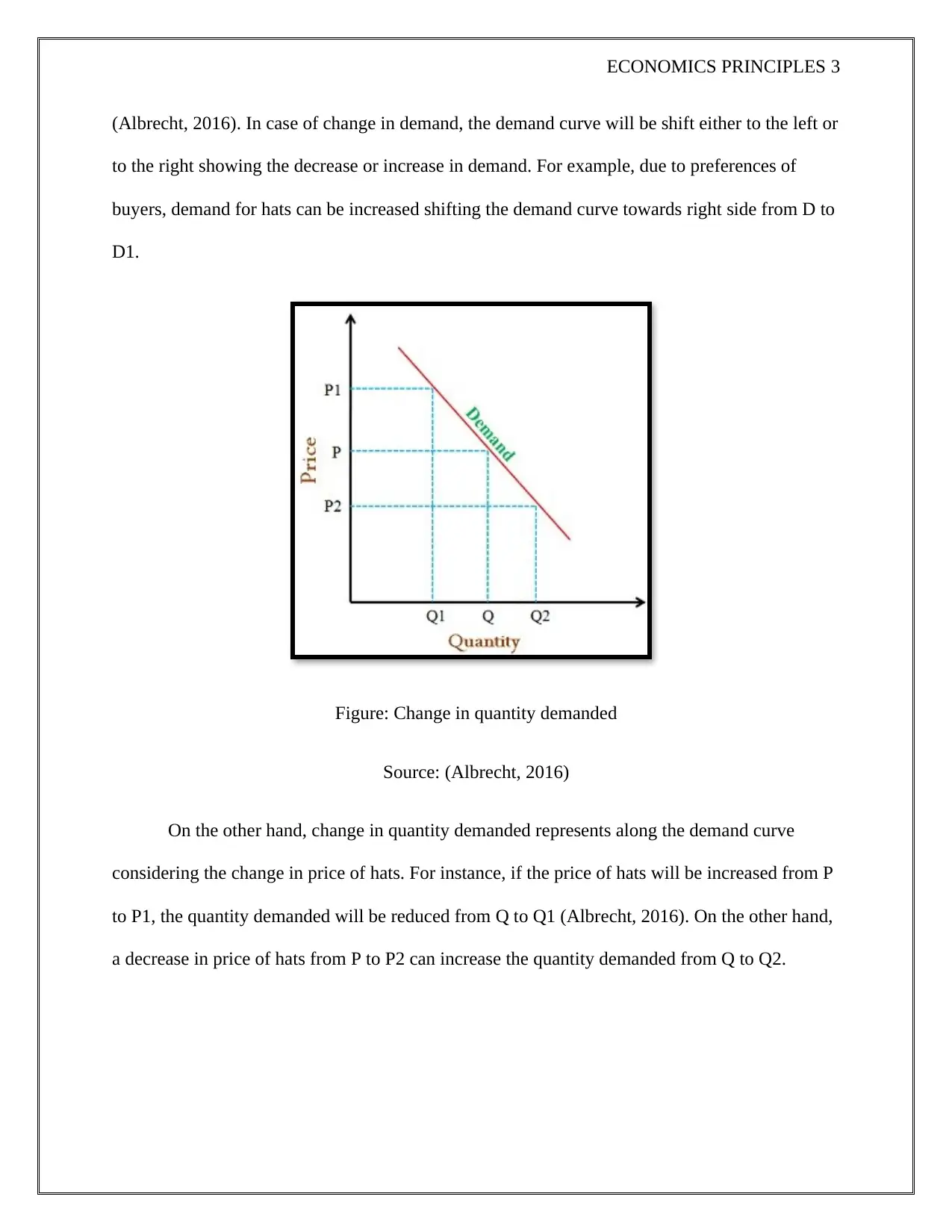
ECONOMICS PRINCIPLES 3
(Albrecht, 2016). In case of change in demand, the demand curve will be shift either to the left or
to the right showing the decrease or increase in demand. For example, due to preferences of
buyers, demand for hats can be increased shifting the demand curve towards right side from D to
D1.
Figure: Change in quantity demanded
Source: (Albrecht, 2016)
On the other hand, change in quantity demanded represents along the demand curve
considering the change in price of hats. For instance, if the price of hats will be increased from P
to P1, the quantity demanded will be reduced from Q to Q1 (Albrecht, 2016). On the other hand,
a decrease in price of hats from P to P2 can increase the quantity demanded from Q to Q2.
(Albrecht, 2016). In case of change in demand, the demand curve will be shift either to the left or
to the right showing the decrease or increase in demand. For example, due to preferences of
buyers, demand for hats can be increased shifting the demand curve towards right side from D to
D1.
Figure: Change in quantity demanded
Source: (Albrecht, 2016)
On the other hand, change in quantity demanded represents along the demand curve
considering the change in price of hats. For instance, if the price of hats will be increased from P
to P1, the quantity demanded will be reduced from Q to Q1 (Albrecht, 2016). On the other hand,
a decrease in price of hats from P to P2 can increase the quantity demanded from Q to Q2.
⊘ This is a preview!⊘
Do you want full access?
Subscribe today to unlock all pages.

Trusted by 1+ million students worldwide
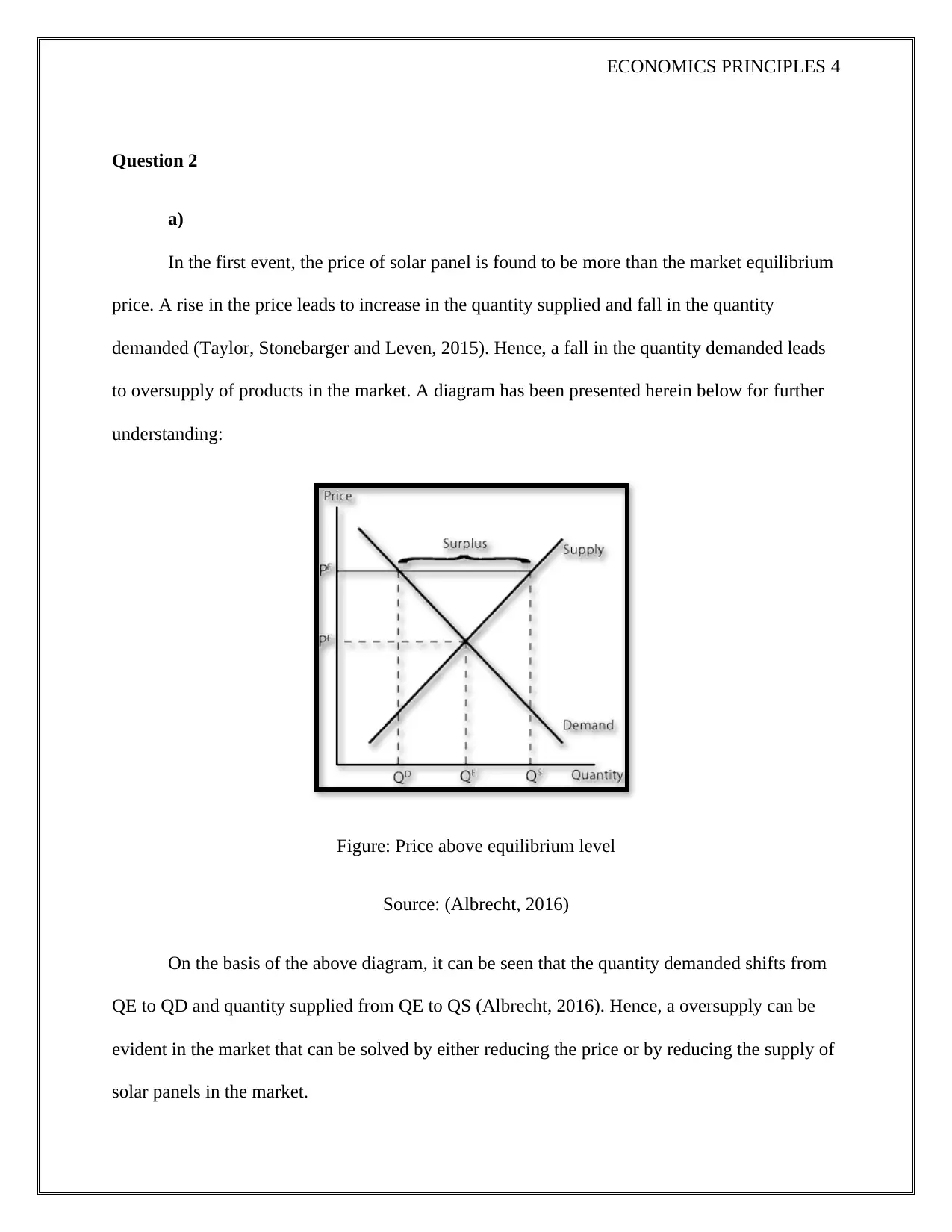
ECONOMICS PRINCIPLES 4
Question 2
a)
In the first event, the price of solar panel is found to be more than the market equilibrium
price. A rise in the price leads to increase in the quantity supplied and fall in the quantity
demanded (Taylor, Stonebarger and Leven, 2015). Hence, a fall in the quantity demanded leads
to oversupply of products in the market. A diagram has been presented herein below for further
understanding:
Figure: Price above equilibrium level
Source: (Albrecht, 2016)
On the basis of the above diagram, it can be seen that the quantity demanded shifts from
QE to QD and quantity supplied from QE to QS (Albrecht, 2016). Hence, a oversupply can be
evident in the market that can be solved by either reducing the price or by reducing the supply of
solar panels in the market.
Question 2
a)
In the first event, the price of solar panel is found to be more than the market equilibrium
price. A rise in the price leads to increase in the quantity supplied and fall in the quantity
demanded (Taylor, Stonebarger and Leven, 2015). Hence, a fall in the quantity demanded leads
to oversupply of products in the market. A diagram has been presented herein below for further
understanding:
Figure: Price above equilibrium level
Source: (Albrecht, 2016)
On the basis of the above diagram, it can be seen that the quantity demanded shifts from
QE to QD and quantity supplied from QE to QS (Albrecht, 2016). Hence, a oversupply can be
evident in the market that can be solved by either reducing the price or by reducing the supply of
solar panels in the market.
Paraphrase This Document
Need a fresh take? Get an instant paraphrase of this document with our AI Paraphraser
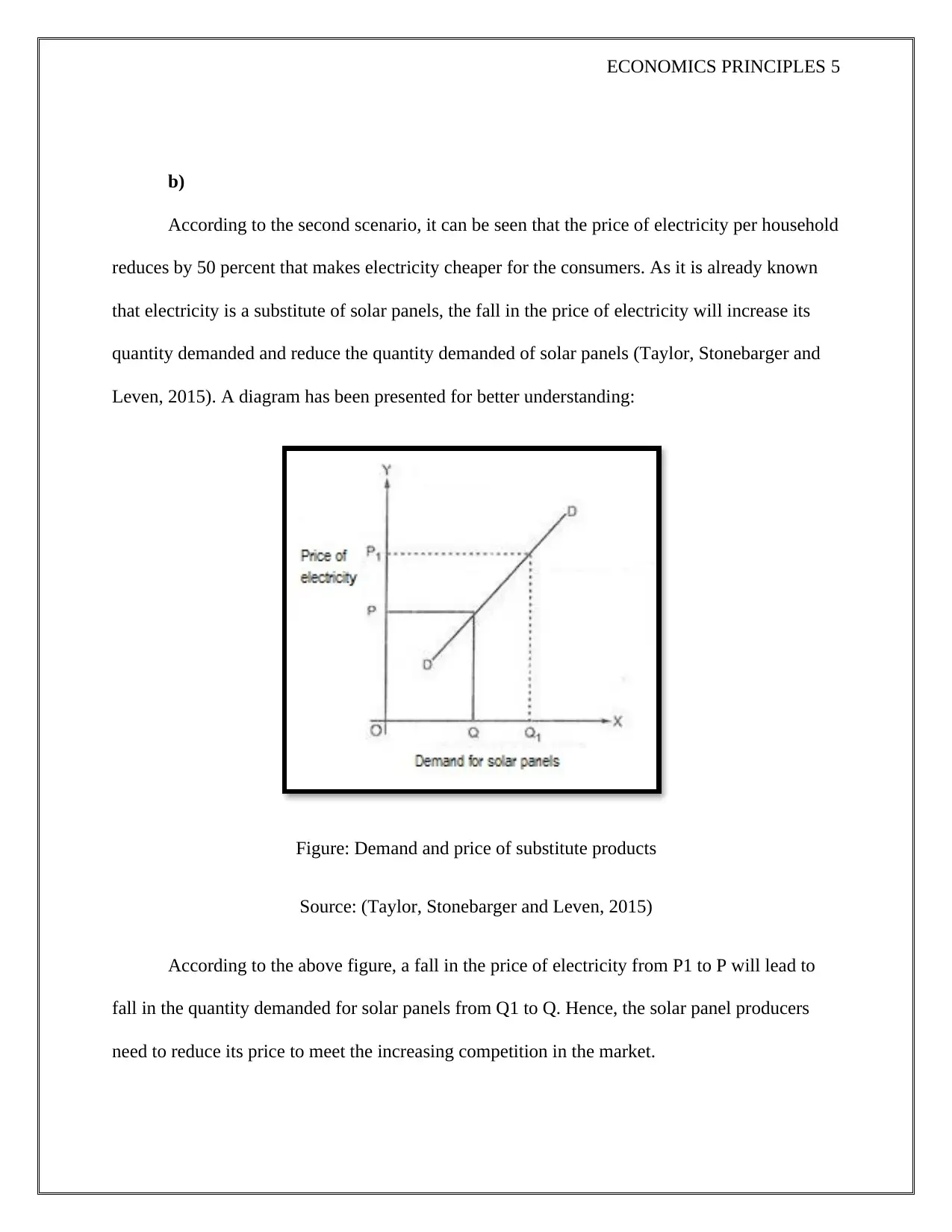
ECONOMICS PRINCIPLES 5
b)
According to the second scenario, it can be seen that the price of electricity per household
reduces by 50 percent that makes electricity cheaper for the consumers. As it is already known
that electricity is a substitute of solar panels, the fall in the price of electricity will increase its
quantity demanded and reduce the quantity demanded of solar panels (Taylor, Stonebarger and
Leven, 2015). A diagram has been presented for better understanding:
Figure: Demand and price of substitute products
Source: (Taylor, Stonebarger and Leven, 2015)
According to the above figure, a fall in the price of electricity from P1 to P will lead to
fall in the quantity demanded for solar panels from Q1 to Q. Hence, the solar panel producers
need to reduce its price to meet the increasing competition in the market.
b)
According to the second scenario, it can be seen that the price of electricity per household
reduces by 50 percent that makes electricity cheaper for the consumers. As it is already known
that electricity is a substitute of solar panels, the fall in the price of electricity will increase its
quantity demanded and reduce the quantity demanded of solar panels (Taylor, Stonebarger and
Leven, 2015). A diagram has been presented for better understanding:
Figure: Demand and price of substitute products
Source: (Taylor, Stonebarger and Leven, 2015)
According to the above figure, a fall in the price of electricity from P1 to P will lead to
fall in the quantity demanded for solar panels from Q1 to Q. Hence, the solar panel producers
need to reduce its price to meet the increasing competition in the market.
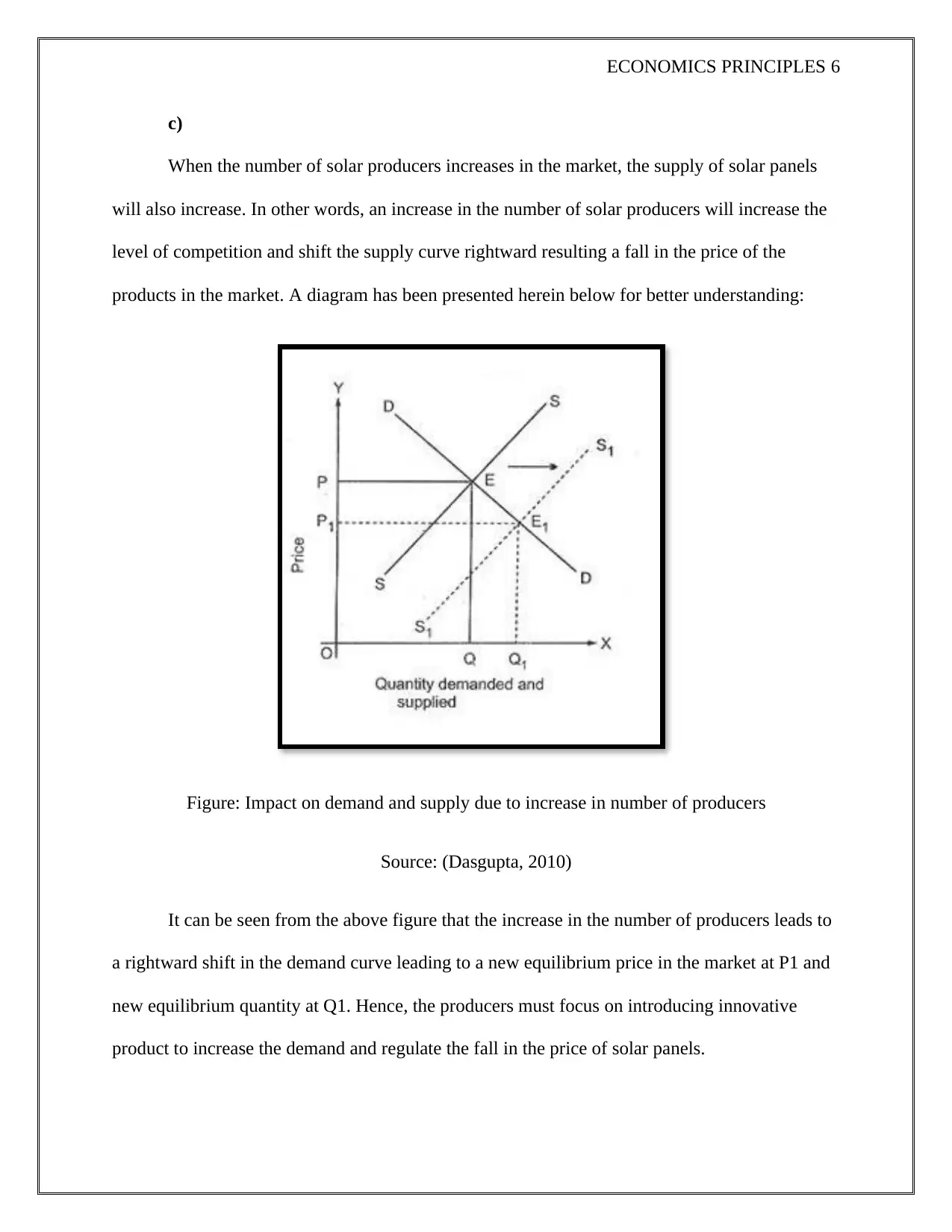
ECONOMICS PRINCIPLES 6
c)
When the number of solar producers increases in the market, the supply of solar panels
will also increase. In other words, an increase in the number of solar producers will increase the
level of competition and shift the supply curve rightward resulting a fall in the price of the
products in the market. A diagram has been presented herein below for better understanding:
Figure: Impact on demand and supply due to increase in number of producers
Source: (Dasgupta, 2010)
It can be seen from the above figure that the increase in the number of producers leads to
a rightward shift in the demand curve leading to a new equilibrium price in the market at P1 and
new equilibrium quantity at Q1. Hence, the producers must focus on introducing innovative
product to increase the demand and regulate the fall in the price of solar panels.
c)
When the number of solar producers increases in the market, the supply of solar panels
will also increase. In other words, an increase in the number of solar producers will increase the
level of competition and shift the supply curve rightward resulting a fall in the price of the
products in the market. A diagram has been presented herein below for better understanding:
Figure: Impact on demand and supply due to increase in number of producers
Source: (Dasgupta, 2010)
It can be seen from the above figure that the increase in the number of producers leads to
a rightward shift in the demand curve leading to a new equilibrium price in the market at P1 and
new equilibrium quantity at Q1. Hence, the producers must focus on introducing innovative
product to increase the demand and regulate the fall in the price of solar panels.
⊘ This is a preview!⊘
Do you want full access?
Subscribe today to unlock all pages.

Trusted by 1+ million students worldwide
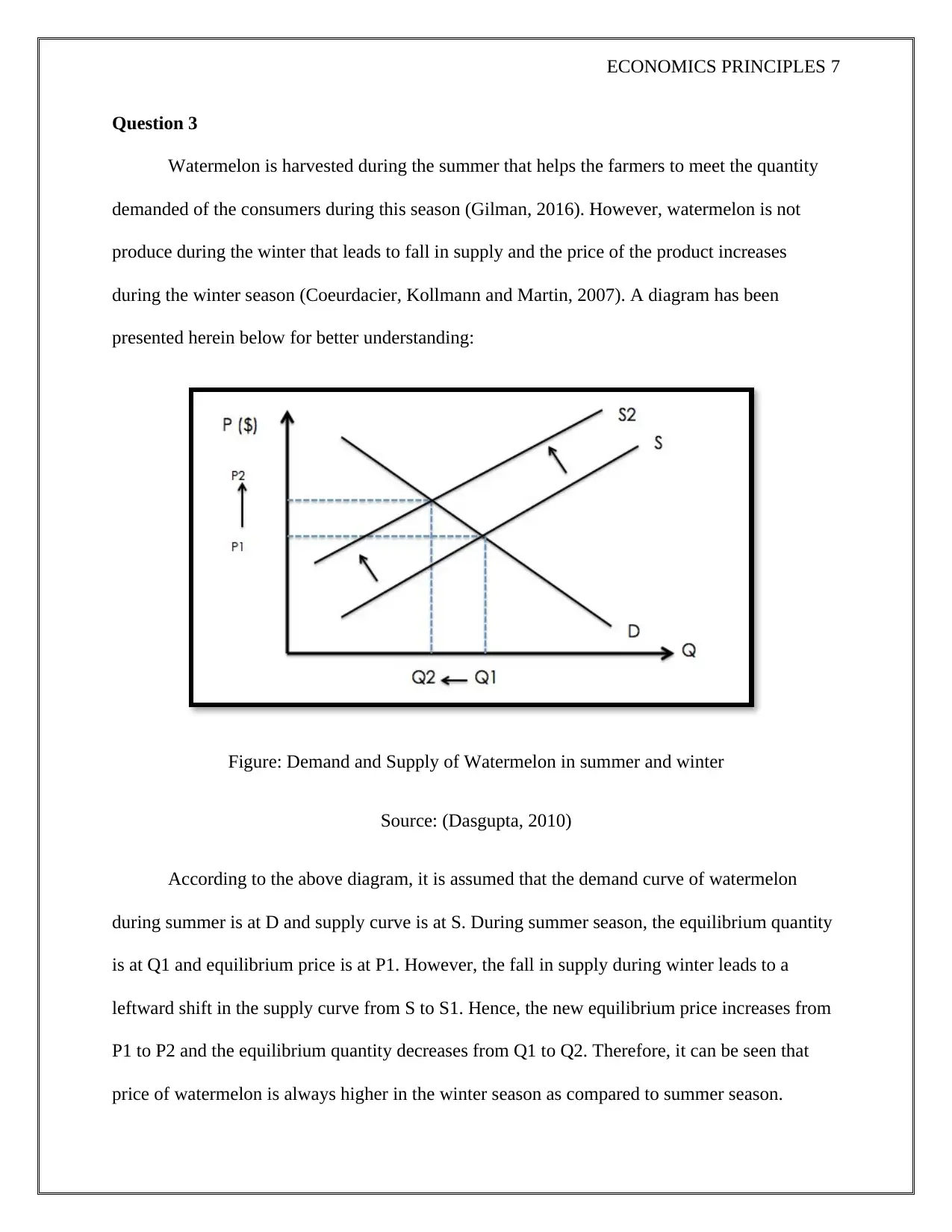
ECONOMICS PRINCIPLES 7
Question 3
Watermelon is harvested during the summer that helps the farmers to meet the quantity
demanded of the consumers during this season (Gilman, 2016). However, watermelon is not
produce during the winter that leads to fall in supply and the price of the product increases
during the winter season (Coeurdacier, Kollmann and Martin, 2007). A diagram has been
presented herein below for better understanding:
Figure: Demand and Supply of Watermelon in summer and winter
Source: (Dasgupta, 2010)
According to the above diagram, it is assumed that the demand curve of watermelon
during summer is at D and supply curve is at S. During summer season, the equilibrium quantity
is at Q1 and equilibrium price is at P1. However, the fall in supply during winter leads to a
leftward shift in the supply curve from S to S1. Hence, the new equilibrium price increases from
P1 to P2 and the equilibrium quantity decreases from Q1 to Q2. Therefore, it can be seen that
price of watermelon is always higher in the winter season as compared to summer season.
Question 3
Watermelon is harvested during the summer that helps the farmers to meet the quantity
demanded of the consumers during this season (Gilman, 2016). However, watermelon is not
produce during the winter that leads to fall in supply and the price of the product increases
during the winter season (Coeurdacier, Kollmann and Martin, 2007). A diagram has been
presented herein below for better understanding:
Figure: Demand and Supply of Watermelon in summer and winter
Source: (Dasgupta, 2010)
According to the above diagram, it is assumed that the demand curve of watermelon
during summer is at D and supply curve is at S. During summer season, the equilibrium quantity
is at Q1 and equilibrium price is at P1. However, the fall in supply during winter leads to a
leftward shift in the supply curve from S to S1. Hence, the new equilibrium price increases from
P1 to P2 and the equilibrium quantity decreases from Q1 to Q2. Therefore, it can be seen that
price of watermelon is always higher in the winter season as compared to summer season.
Paraphrase This Document
Need a fresh take? Get an instant paraphrase of this document with our AI Paraphraser
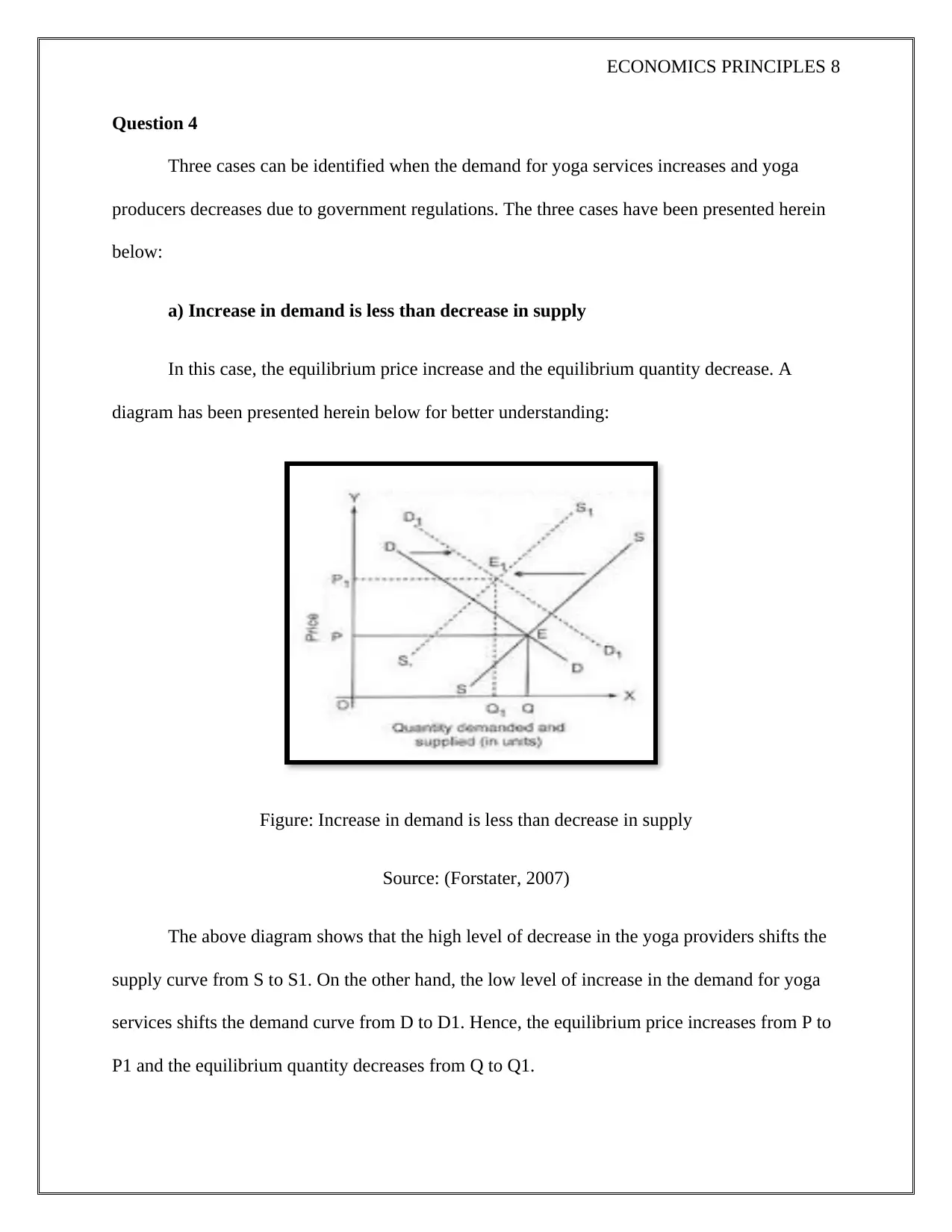
ECONOMICS PRINCIPLES 8
Question 4
Three cases can be identified when the demand for yoga services increases and yoga
producers decreases due to government regulations. The three cases have been presented herein
below:
a) Increase in demand is less than decrease in supply
In this case, the equilibrium price increase and the equilibrium quantity decrease. A
diagram has been presented herein below for better understanding:
Figure: Increase in demand is less than decrease in supply
Source: (Forstater, 2007)
The above diagram shows that the high level of decrease in the yoga providers shifts the
supply curve from S to S1. On the other hand, the low level of increase in the demand for yoga
services shifts the demand curve from D to D1. Hence, the equilibrium price increases from P to
P1 and the equilibrium quantity decreases from Q to Q1.
Question 4
Three cases can be identified when the demand for yoga services increases and yoga
producers decreases due to government regulations. The three cases have been presented herein
below:
a) Increase in demand is less than decrease in supply
In this case, the equilibrium price increase and the equilibrium quantity decrease. A
diagram has been presented herein below for better understanding:
Figure: Increase in demand is less than decrease in supply
Source: (Forstater, 2007)
The above diagram shows that the high level of decrease in the yoga providers shifts the
supply curve from S to S1. On the other hand, the low level of increase in the demand for yoga
services shifts the demand curve from D to D1. Hence, the equilibrium price increases from P to
P1 and the equilibrium quantity decreases from Q to Q1.
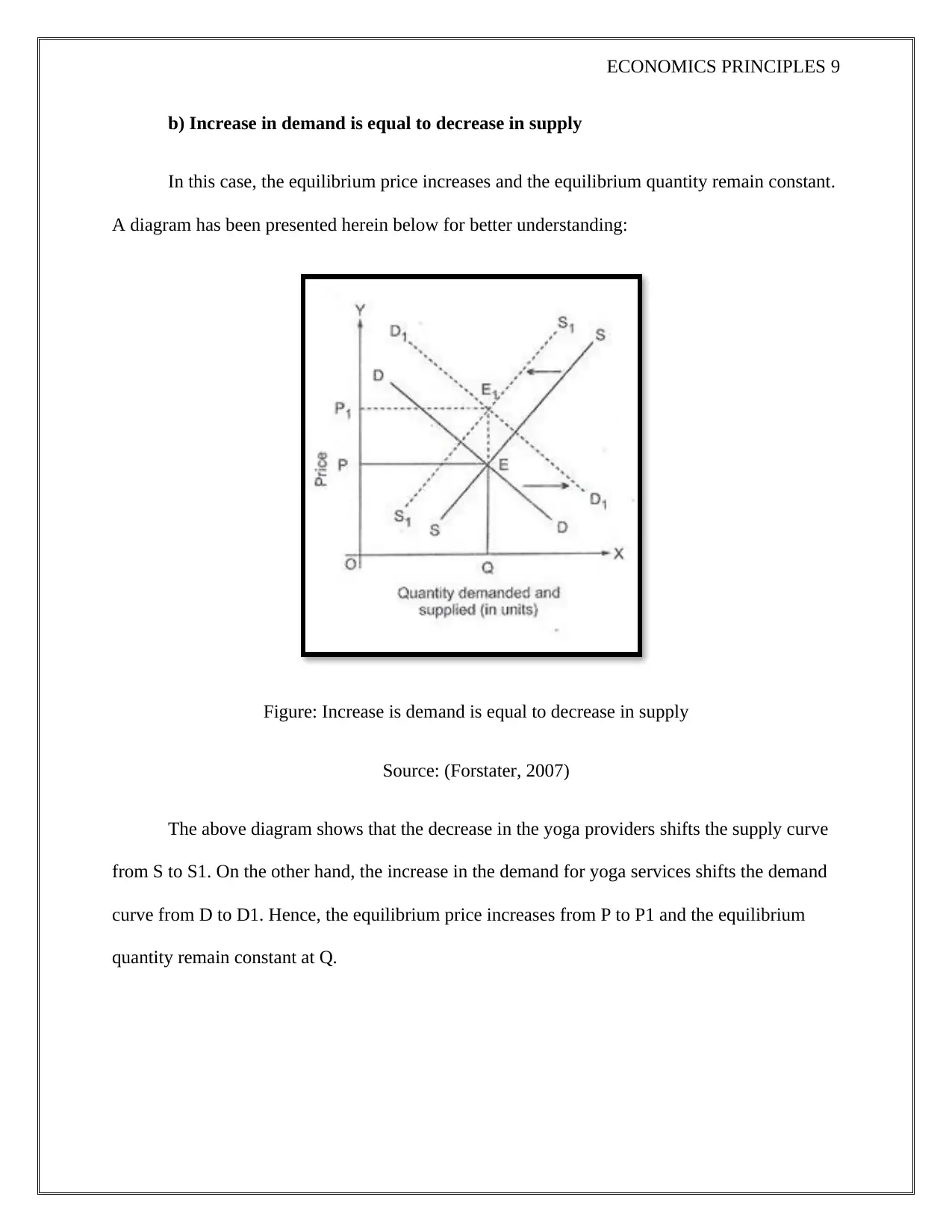
ECONOMICS PRINCIPLES 9
b) Increase in demand is equal to decrease in supply
In this case, the equilibrium price increases and the equilibrium quantity remain constant.
A diagram has been presented herein below for better understanding:
Figure: Increase is demand is equal to decrease in supply
Source: (Forstater, 2007)
The above diagram shows that the decrease in the yoga providers shifts the supply curve
from S to S1. On the other hand, the increase in the demand for yoga services shifts the demand
curve from D to D1. Hence, the equilibrium price increases from P to P1 and the equilibrium
quantity remain constant at Q.
b) Increase in demand is equal to decrease in supply
In this case, the equilibrium price increases and the equilibrium quantity remain constant.
A diagram has been presented herein below for better understanding:
Figure: Increase is demand is equal to decrease in supply
Source: (Forstater, 2007)
The above diagram shows that the decrease in the yoga providers shifts the supply curve
from S to S1. On the other hand, the increase in the demand for yoga services shifts the demand
curve from D to D1. Hence, the equilibrium price increases from P to P1 and the equilibrium
quantity remain constant at Q.
⊘ This is a preview!⊘
Do you want full access?
Subscribe today to unlock all pages.

Trusted by 1+ million students worldwide
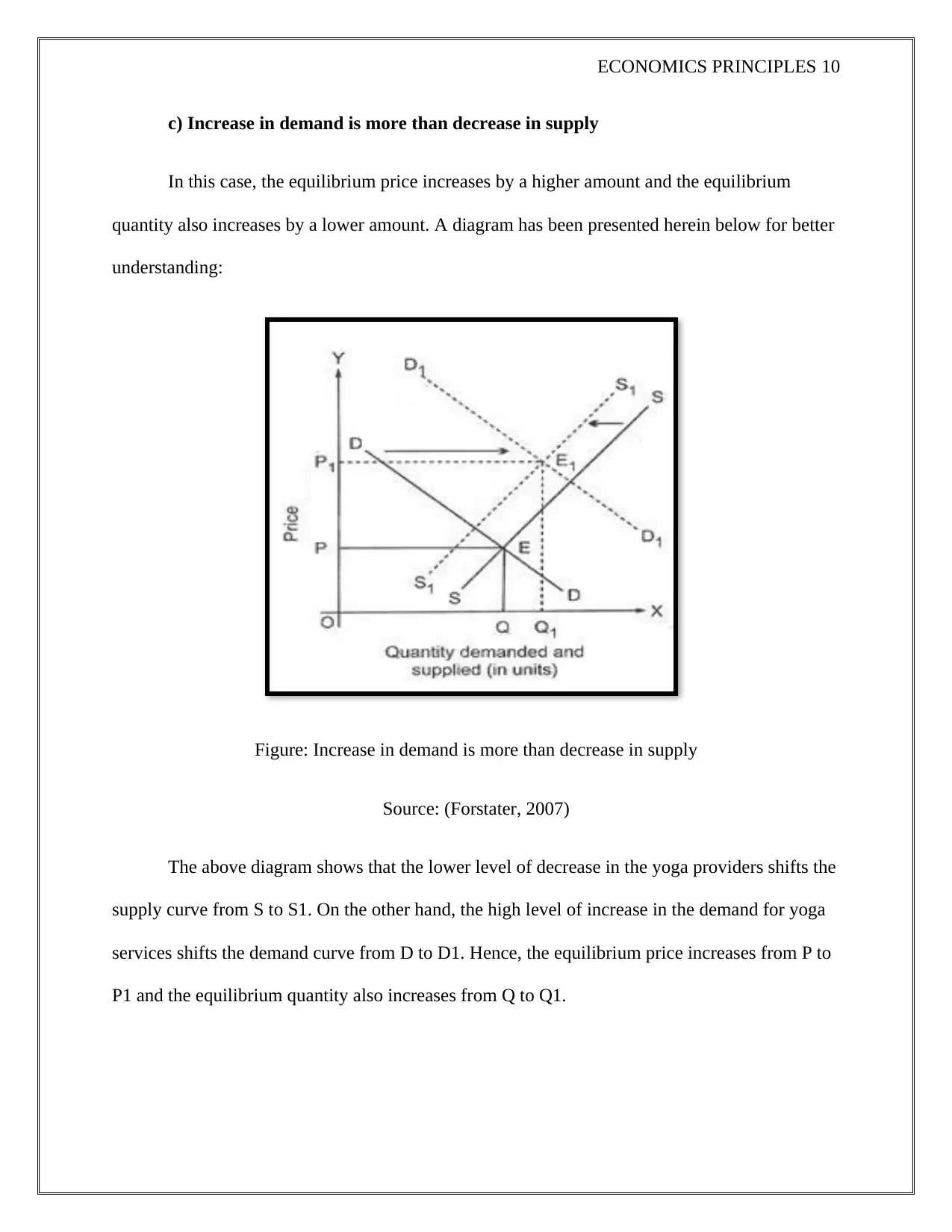
ECONOMICS PRINCIPLES 10
c) Increase in demand is more than decrease in supply
In this case, the equilibrium price increases by a higher amount and the equilibrium
quantity also increases by a lower amount. A diagram has been presented herein below for better
understanding:
Figure: Increase in demand is more than decrease in supply
Source: (Forstater, 2007)
The above diagram shows that the lower level of decrease in the yoga providers shifts the
supply curve from S to S1. On the other hand, the high level of increase in the demand for yoga
services shifts the demand curve from D to D1. Hence, the equilibrium price increases from P to
P1 and the equilibrium quantity also increases from Q to Q1.
c) Increase in demand is more than decrease in supply
In this case, the equilibrium price increases by a higher amount and the equilibrium
quantity also increases by a lower amount. A diagram has been presented herein below for better
understanding:
Figure: Increase in demand is more than decrease in supply
Source: (Forstater, 2007)
The above diagram shows that the lower level of decrease in the yoga providers shifts the
supply curve from S to S1. On the other hand, the high level of increase in the demand for yoga
services shifts the demand curve from D to D1. Hence, the equilibrium price increases from P to
P1 and the equilibrium quantity also increases from Q to Q1.
Paraphrase This Document
Need a fresh take? Get an instant paraphrase of this document with our AI Paraphraser
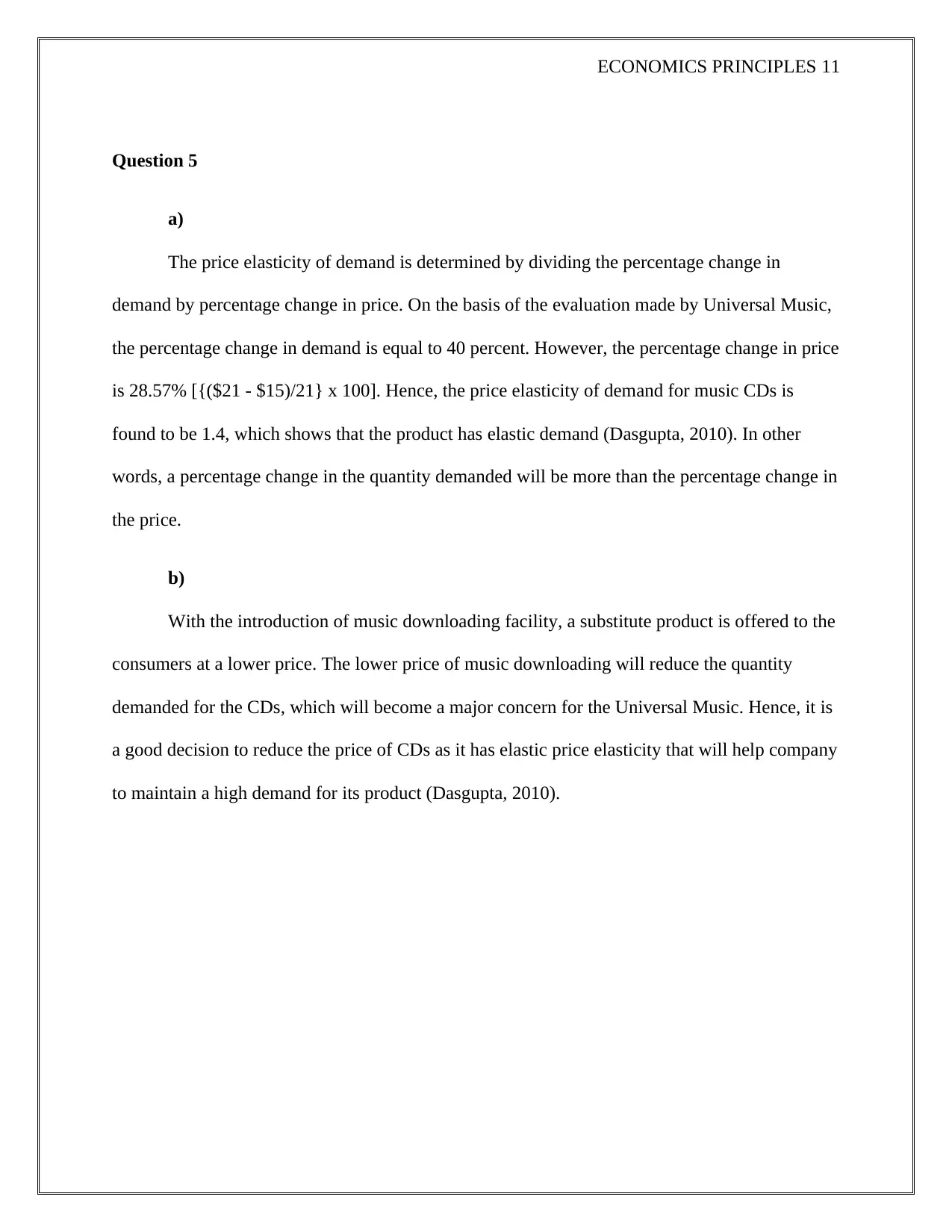
ECONOMICS PRINCIPLES 11
Question 5
a)
The price elasticity of demand is determined by dividing the percentage change in
demand by percentage change in price. On the basis of the evaluation made by Universal Music,
the percentage change in demand is equal to 40 percent. However, the percentage change in price
is 28.57% [{($21 - $15)/21} x 100]. Hence, the price elasticity of demand for music CDs is
found to be 1.4, which shows that the product has elastic demand (Dasgupta, 2010). In other
words, a percentage change in the quantity demanded will be more than the percentage change in
the price.
b)
With the introduction of music downloading facility, a substitute product is offered to the
consumers at a lower price. The lower price of music downloading will reduce the quantity
demanded for the CDs, which will become a major concern for the Universal Music. Hence, it is
a good decision to reduce the price of CDs as it has elastic price elasticity that will help company
to maintain a high demand for its product (Dasgupta, 2010).
Question 5
a)
The price elasticity of demand is determined by dividing the percentage change in
demand by percentage change in price. On the basis of the evaluation made by Universal Music,
the percentage change in demand is equal to 40 percent. However, the percentage change in price
is 28.57% [{($21 - $15)/21} x 100]. Hence, the price elasticity of demand for music CDs is
found to be 1.4, which shows that the product has elastic demand (Dasgupta, 2010). In other
words, a percentage change in the quantity demanded will be more than the percentage change in
the price.
b)
With the introduction of music downloading facility, a substitute product is offered to the
consumers at a lower price. The lower price of music downloading will reduce the quantity
demanded for the CDs, which will become a major concern for the Universal Music. Hence, it is
a good decision to reduce the price of CDs as it has elastic price elasticity that will help company
to maintain a high demand for its product (Dasgupta, 2010).
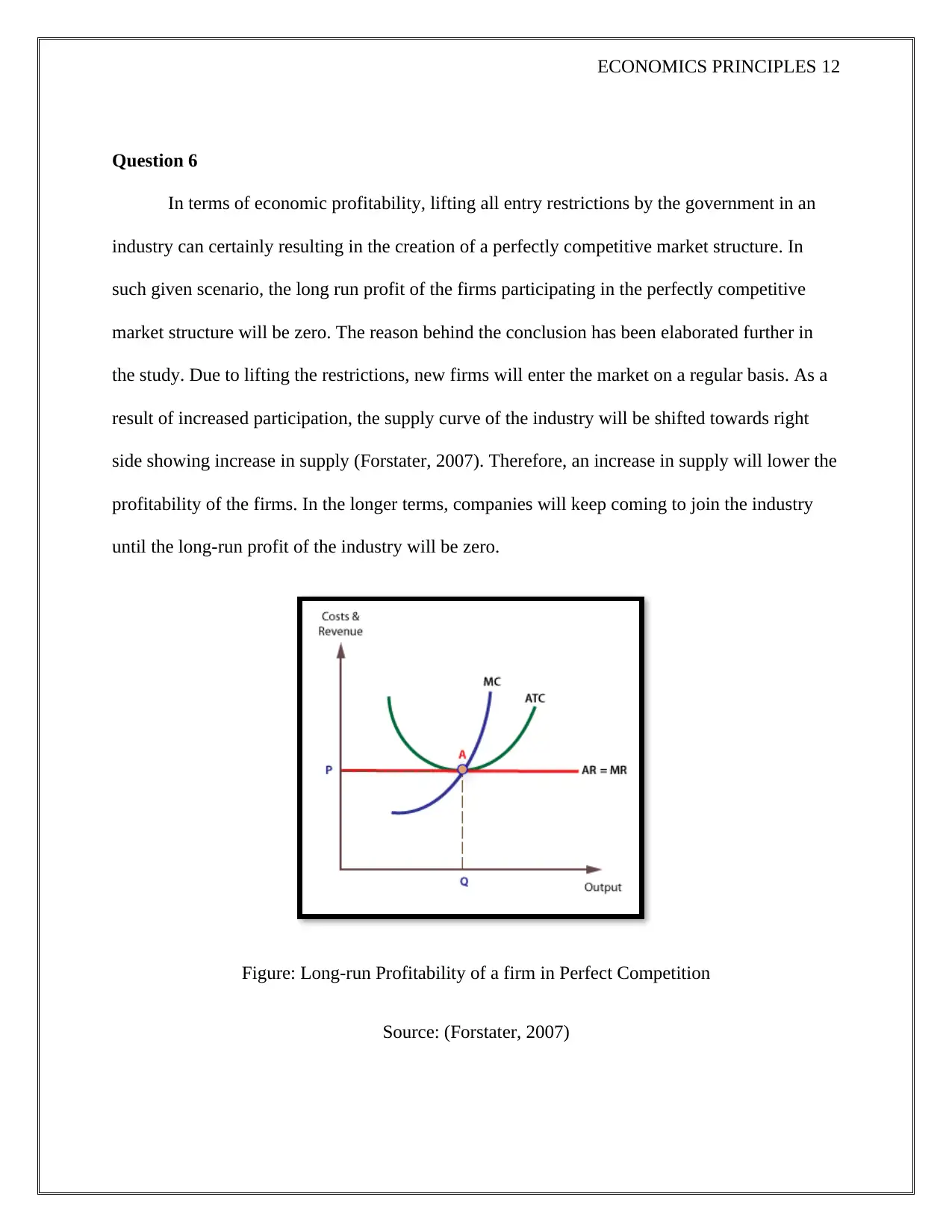
ECONOMICS PRINCIPLES 12
Question 6
In terms of economic profitability, lifting all entry restrictions by the government in an
industry can certainly resulting in the creation of a perfectly competitive market structure. In
such given scenario, the long run profit of the firms participating in the perfectly competitive
market structure will be zero. The reason behind the conclusion has been elaborated further in
the study. Due to lifting the restrictions, new firms will enter the market on a regular basis. As a
result of increased participation, the supply curve of the industry will be shifted towards right
side showing increase in supply (Forstater, 2007). Therefore, an increase in supply will lower the
profitability of the firms. In the longer terms, companies will keep coming to join the industry
until the long-run profit of the industry will be zero.
Figure: Long-run Profitability of a firm in Perfect Competition
Source: (Forstater, 2007)
Question 6
In terms of economic profitability, lifting all entry restrictions by the government in an
industry can certainly resulting in the creation of a perfectly competitive market structure. In
such given scenario, the long run profit of the firms participating in the perfectly competitive
market structure will be zero. The reason behind the conclusion has been elaborated further in
the study. Due to lifting the restrictions, new firms will enter the market on a regular basis. As a
result of increased participation, the supply curve of the industry will be shifted towards right
side showing increase in supply (Forstater, 2007). Therefore, an increase in supply will lower the
profitability of the firms. In the longer terms, companies will keep coming to join the industry
until the long-run profit of the industry will be zero.
Figure: Long-run Profitability of a firm in Perfect Competition
Source: (Forstater, 2007)
⊘ This is a preview!⊘
Do you want full access?
Subscribe today to unlock all pages.

Trusted by 1+ million students worldwide
1 out of 14
Related Documents
Your All-in-One AI-Powered Toolkit for Academic Success.
+13062052269
info@desklib.com
Available 24*7 on WhatsApp / Email
![[object Object]](/_next/static/media/star-bottom.7253800d.svg)
Unlock your academic potential
Copyright © 2020–2025 A2Z Services. All Rights Reserved. Developed and managed by ZUCOL.





